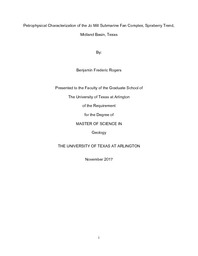| dc.description.abstract | Understanding and quantifying reservoir quality require a new suite of knowledge when approaching the nanometer sized pore-networks of unconventional reservoirs. These low porosity and permeability reservoirs have been produced in major basins all over the world, but characterizing their pore networks has been fairly recent in its application. One of the challenges of quantifying reservoir characteristics like porosity, pore size distribution, permeability, and tortuosity in unconventional reservoirs is the abundance of their nanometer-sized pore systems. Pore systems in these rocks tend to behave differently and with less predictability than the conventional reservoir. The Spraberry Formation in the Midland Basin of West Texas has become one of the world’s leading unconventional plays, especially when coupled with the underlying Wolfcamp Formation. The pore systems in the Spraberry Formation lead to steep production decline and low sweep efficiency. Samples from the lower Spraberry, in a zone known as the Jo Mill submarine fan complex, were taken to better understand these pore systems and to quantify their characteristics. Four samples of various lithological and organic matter properties, but of close stratigraphic relation to the Jo Mill zone in the Nobles 3202 well in Midland County, Texas, were analyzed. The methodologies used to investigate these nanometer sized pore systems were developed in an attempt to quantify properties such as porosity, pore size distribution, permeability and tortuosity, and their relation to hydrocarbon presence and mineralogy. The tests used included x-ray diffraction, pyrolysis and total organic carbon (TOC), helium porosity and permeability, mercury intrusion porosimetry, low-pressure nitrogen physisorption, contact angle analysis, fluid imbibition, and well logging analysis for porosity, TOC, and water saturation.
The variety of sample size and the diversity of experimentation conducted are the keys to investigating the complex nature of the pore networks in the Jo Mill zone. The samples taken with various lithology and organic matter content give insight to a multitude of pore systems that can occur in the Jo Mill zone. The petrophysical properties of this unconventional reservoir are the foundation for understanding the behavior of fluid movement within its pores. Results from each experiment shed light on the benefits and precautions of certain methods. Overall, the Jo Mill samples exhibit quantifiable correlations between pore size distribution, porosity, and permeability with grain size distribution, lithofacies, and TOC. | |


